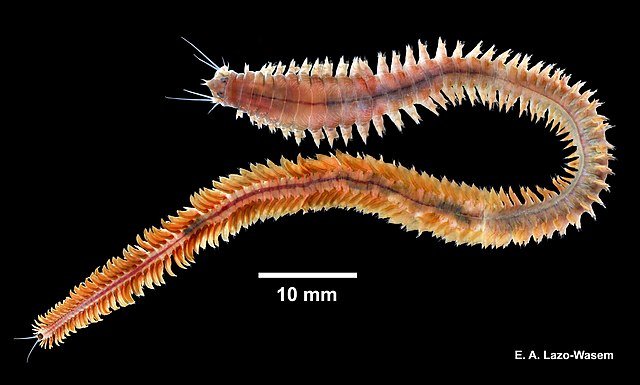
In the pursuit of sustainable aquaculture, attention has shifted towards alternatives to fish-derived ingredients, driven by concerns about economic and environmental sustainability.
Low-trophic organisms, particularly polychaetes, have emerged as promising candidates due to their high protein content. These species boast a well-balanced nutritional profile, characterized by high protein content and elevated levels of omega-3 fatty acids.
Researchers from the Interdisciplinary Center of Marine and Environmental Research at the University of Porto, Nofima, and Project HUB-360 investigated the potential of substituting fish meal with polychaete meal (Alitta virens) in the diets of European sea bass (Dicentrarchus labrax) juveniles. The aim was to assess its impact on growth, nutrient utilization, and environmental sustainability.
Polychaetes as Aquaculture Feed Ingredient
Polychaetes have been used as a dietary supplement in shrimp maturation diets; however, their potential as a new protein source in aquaculture feeds remains largely unexplored.
The limited availability of marine annelid worms has hindered their economical and environmentally sustainable exploitation, restricting studies on their potential as a protein source in fish feed. Nevertheless, initial experiences in the cultivation of these marine worms will provide the necessary raw material for their use as ingredients in aquaculture feeds.
The Experiment
European sea bass juveniles were fed four diets for 93 days, including a fish meal-based diet (FM) and three experimental diets incorporating polychaete meal (PM) at inclusion levels of 2.5% (PM2.5), 5% (PM5), and 10% (PM10). These diets replaced 10%, 20%, and 40% of the fish meal, respectively. The study analyzed various parameters, including growth, digestibility, nutrient utilization, plasma metabolites, liver lipogenic activity, anterior intestine histomorphology, and environmental impact.
Promising Results
All diets, including those with PM, were well-accepted by the fish, promoting equal growth and high feed efficiency. Importantly, the muscle content of EPA + DHA, essential fatty acids crucial for human consumption, exceeded recommended levels in all dietary groups.
“This study successfully demonstrated that commercially available PM can effectively replace up to 40% of high-quality fish meal in European sea bass diets without compromising growth, feed utilization, and the nutritional value of the flesh, while enhancing environmental performance,” report the scientists.
Stay Always Informed
Join our communities to instantly receive the most important news, reports, and analysis from the aquaculture industry.
They also emphasize that the inclusion of polychaete meal has no significant effect on the overall composition of the fish.
Understanding the Impacts on Lipid Metabolism
At low inclusion levels (PM2.5), according to scientists, PM appeared to influence lipid metabolism, leading to increased hepatic lipogenesis and alterations in plasma levels of triglycerides and non-esterified fatty acids (NEFA). However, these effects did not translate into negative impacts on nutrient digestibility and growth performance.
The study also suggested that PM2.5 improved the absorption capacity of the anterior intestine, showing increased villus length and a higher number/area of goblet cells.
Environmental Sustainability
An assessment of environmental sustainability revealed that diets incorporating PM presented a more sustainable option compared to traditional fish meal diets. The best environmental performance was observed with diets containing between 5% and 10% PM content. This highlights the potential of PM as an environmentally friendly alternative, aligning with the broader goal of sustainable aquaculture.
Conclusion
In summary, this study marks a significant step forward in aquaculture practices, demonstrating that polychaete meal can be a viable and sustainable alternative to fish meal in European sea bass diets.
“Overall, the results of this study clearly show that the replacement of fish meal with PM, up to 40%, does not compromise growth or nutrient utilization while representing a more environmentally sustainable protein source in aquaculture feeds,” concluded the scientists.
They also report that all experimental diets ensured high fillet quality, providing high levels of EPA + DHA exceeding the 250 mg recommended by EFSA for daily human consumption.
The study was funded under the SIDESTREAM Project, which receives financial support from the ERA-NET BLUE BIOECONOMY COFUND of the FCT – Foundation for Science and Technology.
Contact
L.M.P. Valente
CIIMAR, Centro Interdisciplinar de Investigação Marinha e Ambiental
Terminal de Cruzeiros do Porto de Leixões
Av. General Norton de Matos, S/N, 4450-208 Matosinhos, Portugal.
Email: lvalente@icbas.up.pt
Reference (open access)
M. Monteiro, R.S. Costa, V. Sousa, A. Marques, T. Sá, L. Thoresen, S.A. Aldaghi, M. Costamagna, M. Perucca, K. Kousoulaki, L.M.P. Valente. 2024. Towards sustainable aquaculture: Assessing polychaete meal (Alitta virens) as an effective fishmeal alternative in European seabass (Dicentrarchus labrax) diets, Aquaculture, Volume 579, 2024, 740257, ISSN 0044-8486, https://doi.org/10.1016/j.aquaculture.2023.740257.
Editor at the digital magazine AquaHoy. He holds a degree in Aquaculture Biology from the National University of Santa (UNS) and a Master’s degree in Science and Innovation Management from the Polytechnic University of Valencia, with postgraduate diplomas in Business Innovation and Innovation Management. He possesses extensive experience in the aquaculture and fisheries sector, having led the Fisheries Innovation Unit of the National Program for Innovation in Fisheries and Aquaculture (PNIPA). He has served as a senior consultant in technology watch, an innovation project formulator and advisor, and a lecturer at UNS. He is a member of the Peruvian College of Biologists and was recognized by the World Aquaculture Society (WAS) in 2016 for his contribution to aquaculture.




